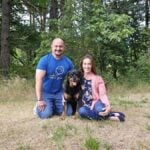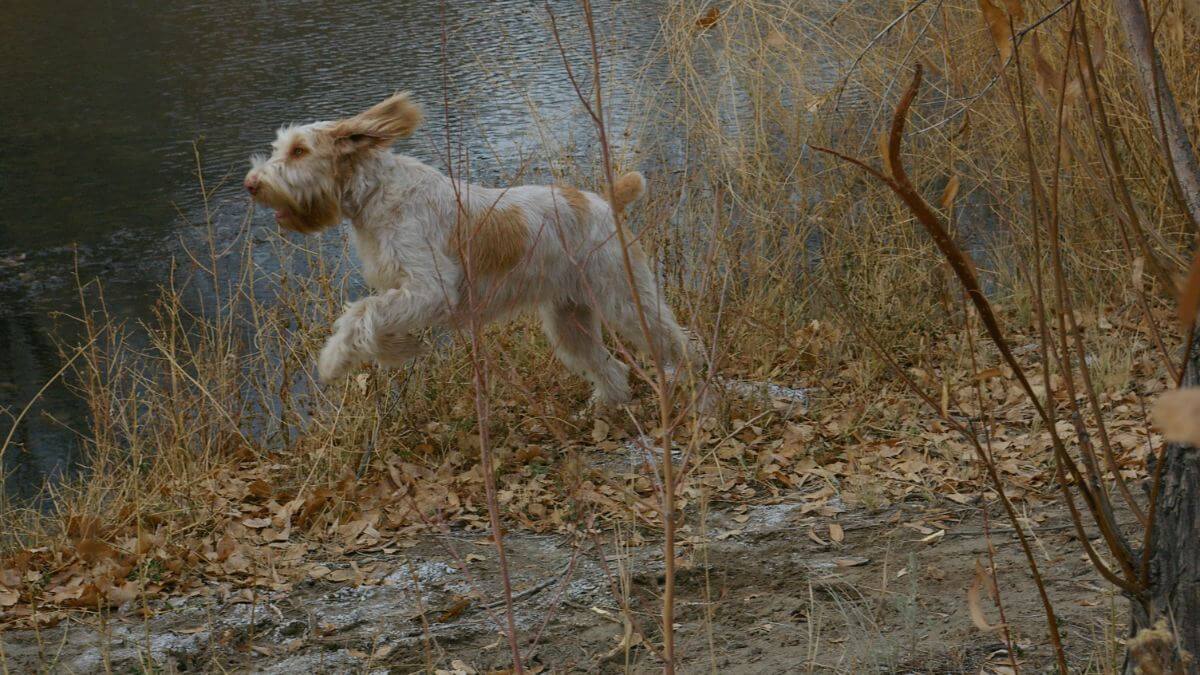


Home » The Spinone Italiano Toplines, Croups & Tailsets – is There More?

This article was originally published in Showsight Magazine, October 2015 issue.
The Spinone Club of America’s Judges Education Committee is working hard to develop a strong education program for the breed. With committee members becoming more accessible to both judges and breeders, we often ask Spinone judges some basic questions. Common responses typically focus on toplines, croups, and tailsets, as well as the judge’s emphasis on these areas when making decisions. Additionally, many judges check for divergent head planes.
While it is reassuring that judges are familiar with these fundamental traits, we would like to highlight some important details to further expand your understanding.
The Spinone’s almost-human expression, which is essential to the breed, is created by its widely-placed, nearly round, large, and expressive eyes. These eyes are set on the frontal plane of the head, a feature unique to the breed. The stop’s definition, along with the suborbital and supraorbital structures (the brow and cheek chiseling), are subtly defined. These elements, along with the warm ochre color in white/orange dogs, contribute to the human-like expression. In brown roan dogs, the eye color is a soft, warm brown. A sharp or intense expression, caused by incorrect eye color, shape, or set—typical of breeds like the Wirehaired Pointing Griffon or German Wirehaired Pointer – hould be penalized in the Spinone Italiano.
The Spinone’s head is long, lean, and divergent. It has a head length that is proportionally longer than most other Sporting breeds, around four-tenths of the dog’s height. The skull has a roof-shaped appearance, marked by a prominent occiput and well-defined interparietal crest (the back skull/nape of the neck). The lateral walls slope gently. In profile, these characteristics contribute to defining the Spinone’s breed type. From the front, the skull’s refinement adds to the long, lean, and divergent look. Although the word “robust” might imply more substance compared to other Sporting breeds, it is balanced and refined.
In profile, the Spinone’s outline is unique, featuring a gently broken topline and nearly level underline. An underline that rises significantly toward the loin, such as in breeds like the German Shorthaired Pointer or setter, is a fault. Spinone movement is unique in that it is relaxed and energy-conserving. Built for stamina, the Spinone’s movement is similar to that of other trotting breeds. There is flexibility in the wrist joint, and with widely-placed scapulae, the large, round front feet rise and fall without exaggeration. When moving, the profile should maintain its unique shape.
The backline remains gently broken in Spinoni with symmetrical angles. Any imbalance in the angles will create undesirable movements such as level or sloping gaits, or the highly undesirable downhill movement. Any exaggeration or imbalance in the front and hind assemblies will negatively affect the profile during movement. A Spinone lacking proper upper arm length, depth, and breadth of chest, or excessive tibia length, will demonstrate a more shortened or improper structure.
From the front, the divergent head planes are evident, where the wide-open nostrils obscure clear viewing of the eyes in dogs with incorrect parallel or convergent planes. TIP: Lift the head of each exhibit to check for the soft, human expression and divergence of planes. If you can clearly view the nostrils, the planes are incorrect. Converging planes or a dish-faced muzzle should be heavily penalized and eliminated from competition.
Ears on the Spinone are long, framing the face unobtrusively with minimal erectile power. They are set low, level with the eye line. TIP: A tight lead can obscure your view of the correct ear placement, roof-shaped skull, divided dewlap, and marked back skull—traits that contribute to the breed’s correct silhouette.
The Spinone is a robustly-boned, versatile breed used for hunting, pointing, and retrieving. Its body is almost square-shaped, with a bone structure described as “oval,” which provides a more refined appearance from the front. The shoulder assembly mirrors the rear, featuring clear definition of the prosternum and a deep, broad chest. The correctly-constructed Spinone carries its head just above the backline, with the nose pointing slightly downwards. This design makes the breed unsuitable for the extreme gaits of breeds like the German Wirehaired Pointer, which is built for faster pace in wide open countryside.
The desired gait for the Spinone in the field is an extended trot with occasional galloping strides. Therefore, the breed’s anatomy is optimized for trotting. TIP: Observing the dog’s loose-lead gait at a natural pace will reveal more than just foot placement. Look for a deep underline, the lightly broken topline, and the correct proportions (long head, almost-square body, equal leg/chest depth, and symmetry of angles).
The high carriage of the head is undesirable and may indicate poor shoulder placement or an upright front assembly.
Finally, the Spinone’s wiry, close-fitting coat is essential. Judges should examine both the texture and the lay of the coat at the midline of the ribcage, not along the withers or backline. The correct coat may appear too short from a distance, so it’s important to evaluate it carefully. Coats that are soft or have an undercoat may stand away from the body, which is incorrect for the breed. Grasp the skin as you examine the coat to ensure it’s thick and leathery. Thin skin often indicates an incorrect coat. The coat should measure between 1 ½” and 2 ½” in length, and the texture, lay, and length are all crucial in evaluating coat type. The skin itself is of equal importance.
On the head, shorter hair is desirable and may be hand-stripped to highlight the breed’s important traits. Stripping dead hair or tidying up the body coat is not considered sculpting or molding, but the use of scissors is contrary to the Breed Standard. Dogs with the correct wiry texture will require minimal hand-stripping. Poor quality coats may not strip well, and excessive soft leg hair or scissor marks may indicate pre-grooming. These signs should alert judges to evaluate the coat quality carefully.
We hope this information will help judges gain a better understanding of the Spinone Italiano. We appreciate your time in reading this and encourage you to contact us with any questions or feedback at SCOAJudgesEd@gmail.com.